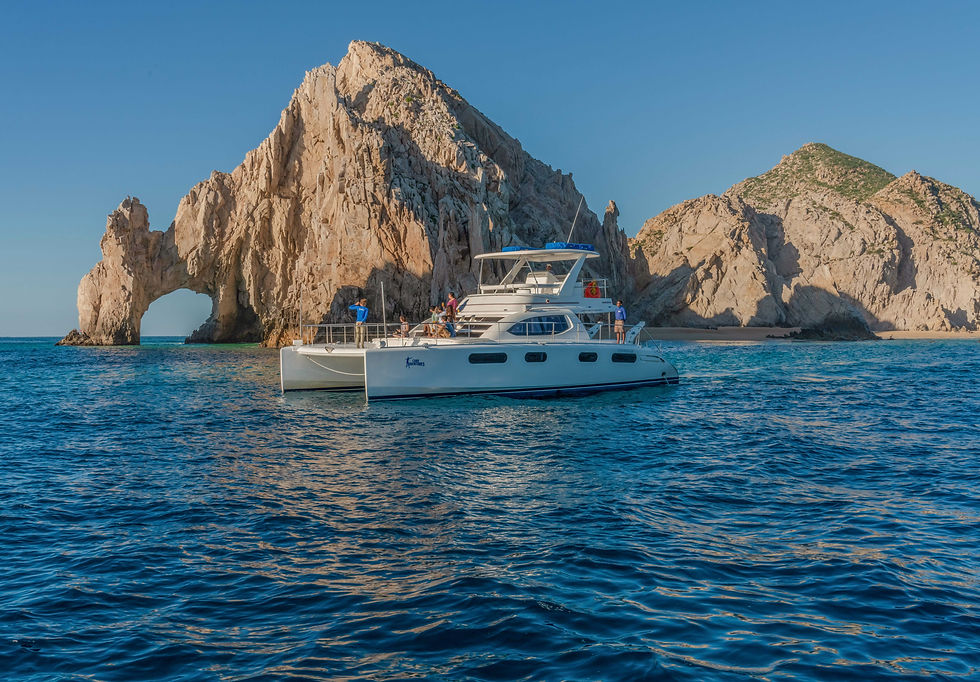Ultimate Guide to Humpback Whales
- ISA

- Dec 21, 2023
- 3 min read
A Symphony of the Seas
The deep blue expanse of the ocean conceals mysteries, and none are as captivating as the journey of the humpback whale. In this comprehensive guide, we invite you to dive into the depths of knowledge about these gentle giants—exploring their feeding habits, extraordinary migrations, and unraveling the tapestry of fascinating facts that make them such awe-inspiring creatures. Don't forget, you can see these gentle giants up close and personally with our Luxury Whale Watching Tour.


A Feast Beneath the Waves
Picture a serene underwater ballet where humpback whales gracefully maneuver through schools of tiny krill and small fish. The humpback's feeding technique, known as lunge feeding, is a breathtaking display of nature's precision. With mouths agape, they draw in massive amounts of water and then, with an almost artistic finesse, use their baleen plates to sift out their prey.
The Great Migration Ballet
The humpback whale migration is a saga that unfolds across oceans, a testament to the incredible navigational skills and endurance of these marine nomads. Covering thousands of miles between their feeding and breeding grounds, humpback whales embark on an annual odyssey. We'll guide you through the patterns and routes of this great migration ballet, providing insight into the challenges and triumphs faced by these oceanic wanderers.
Fun Facts That Make a Splash

Majestic Singers:
Humpback whales are renowned for their complex and haunting songs. These songs can last up to 20 minutes and are thought to be a form of communication among the whales, especially during the mating season.
Giant Hearts:
The heart of a humpback whale can weigh as much as half a ton (500 kilograms), about the size of a small car. This powerhouse organ is necessary to pump blood through their enormous bodies.

Intricate Flippers:
Humpback whales have distinctively long pectoral fins, often measuring up to one-third of their body length. These fins, also known as flippers, are incredibly versatile and are often used in various social behaviors, like slapping the water or other whales.
Playful Breachers:
Humpback whales are famous for their acrobatic displays, including breaching, where they leap out of the water and crash back down. While the exact reasons for breaching are not fully understood, it's believed to serve multiple purposes, including communication and potentially to dislodge parasites.

Baleen Plates Filter Feeders:
Instead of teeth, humpback whales have baleen plates in their mouths. These hair-like structures act as a filter, allowing the whale to consume large quantities of small prey, like krill and small fish, during feeding.
Global Nomads:
Humpback whales are champion long-distance travelers. They migrate up to 16,000 miles (25,000 kilometers) round trip every year, moving between their feeding and breeding grounds. This migration is one of the longest known journeys undertaken by any mammal.
Maternal Bonds:
Female humpback whales are dedicated mothers. They invest a lot of time and energy in raising their calves, nursing them for about a year. During this time, the mother is highly protective and nurturing.

Distinctive Tail Flukes:
Each humpback whale has a unique pattern on the underside of its tail flukes, much like a fingerprint. Scientists use these distinct markings to identify individual whales, contributing to research and conservation efforts.
Slow Swimmers:
Despite their massive size, humpback whales are surprisingly slow swimmers. Their average speed is around 3 to 9 miles per hour (4.8 to 14.5 kilometers per hour). However, they can reach bursts of higher speed when needed.
Conservation Success:
Humpback whales were severely depleted by commercial whaling in the 20th century. However, dedicated conservation efforts, including the establishment of protected areas and a ban on commercial whaling, have led to significant population recovery. The humpback whale is now celebrated as a conservation success story.
Cabo's Front-Row Seat to the Symphony
As we bring this journey to a crescendo, we turn our gaze to Cabo San Lucas, a privileged theater for the humpback whale symphony. Here, Baja Pass provides an exclusive invitation to witness these majestic beings in action. Through 2-for-1 deals on whale-watching tours, you can secure a front-row seat to the breathtaking spectacle of humpback whales in their natural habitat. Feel the anticipation as you embark on an adventure that promises not just observation but an immersive experience with these oceanic wonders.

Echoes of the Ocean's Magic

In conclusion, our guide has merely scratched the surface of the enchanting world of humpback whales. As you ponder the echoes of their songs, the elegance of their feeding, and the grandeur of their migrations, remember that Baja Pass is your gateway to this world. Offering exclusive opportunities to witness humpback whales in Cabo, Baja Pass ensures that your journey into the heart of the ocean's magic is not just informative but a profoundly moving experience.
Baja Pass offers 2x1 deals on whale-watching tours in Cabo, providing an unparalleled opportunity to witness the grace and grandeur of humpback whales. Dive into the adventure and make memories that will linger in the echoes of the ocean.



Comments